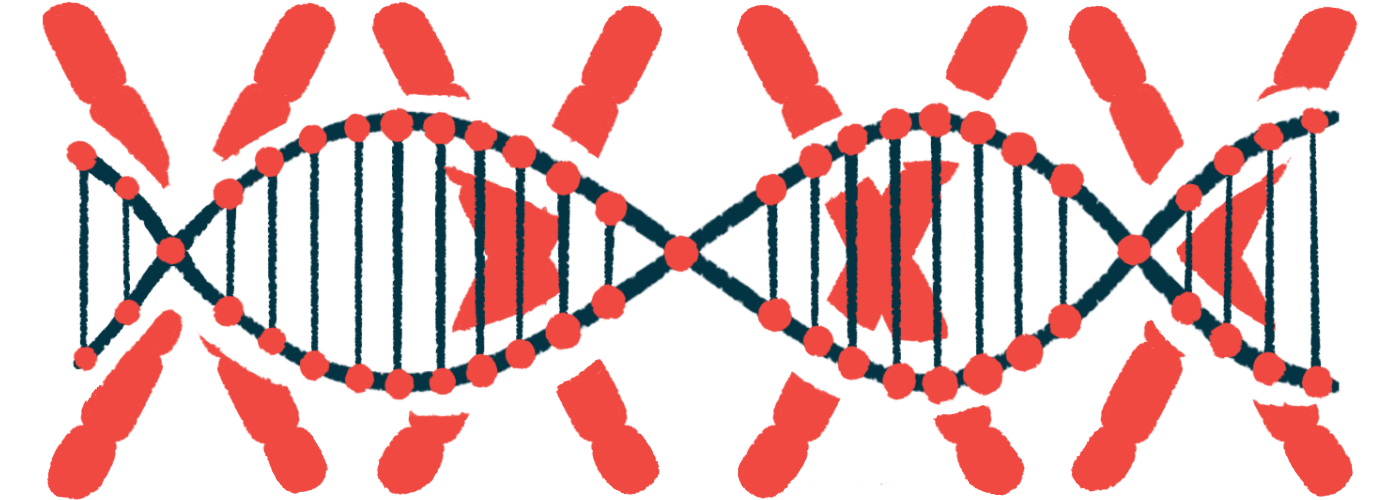Girl Inherits EDS From Father With Mutation in Some of His Cells
Phenomenon known as gonosomal mosaicism is thought to be 'exceedingly rare'

Researchers have identified a rare type of disease-causing mutation, called a multi-exon deletion in the COL5A1 gene, in a girl with classical Ehlers-Danlos syndrome (cEDS).
The girl inherited the disease from her father, who showed no symptoms but carried the mutation in some of his cells but not others — a phenomenon known as gonosomal mosaicism.
This case is the third reported of gonosomal mosaicism in classical EDS, and calls for the use of more sensible methods to more accurately assess the frequency of this phenomenon in people living with EDS, researchers noted.
The case study, “Multi-exon COL5A1 deletion in a child with classical Ehlers–Danlos syndrome: A case report expanding the allelic spectrum and showing evidence of parental gonosomal mosaicism,” was published in Clinical Case Reports.
Classical EDS is usually caused by mutations in COL5A1 or COL5A2 gene
Most cases of classical EDS are caused by mutations in the COL5A1 or COL5A2 gene, with inheritance of a single mutated copy being sufficient to cause the disease. The vast majority of disease-causing mutations in these genes are point mutations, meaning that only one nucleotide (the building blocks of the genetic code) is altered.
Multi-exon deletions, when a large chunk of the gene is missing, are much rarer, accounting for less than 1% of documented classical EDS cases.
Now, researchers in Finland and the U.K. described the rare case of a girl in Finland with classical EDS caused by a multi-exon deletion in the COL5A1 gene.
The girl, who had no family history of the disease, first showed signs of unusual tissue fragility at around one year of age.
“During toddlerhood, she presented with frequent episodes of trivial trauma causing easy bruising, soft tissue swelling, skin wounds requiring suturing [stitches], and causing abnormal scarring,” the researchers wrote. She also had exceptionally mobile joints, all of which are common symptoms of classical EDS.
The girl was first evaluated for a potential bleeding disorder, but after results came back normal, she was referred to a geneticist to be evaluated for potential classical EDS.
For the initial genetic test, the girl underwent next-generation sequencing (NGS) of the COL5A1 and COL5A2 genes. While the test failed to detect any disease-causing mutation, the girl’s clinical presentation still strongly supported classical EDS as the cause.
NGS is effective at identifying point mutations, as it involves determining the exact genetic code for small pieces of the gene then stitching them together. However, this process makes it less well-suited for identifying large genetic deletions.
We speculate that gross [large] deletions of COL5A1 or COL5A2 may be an underrecognized cause of classical EDS
Girl undergoes another test that detects large multi-exon deletion
With this in mind, the researchers decided to analyze the girl’s COL5A1 gene with another genetic technique called Multiplex Ligation-dependent Probe Amplification, which can more efficiently detect large genetic alterations. The result revealed a large multi-exon deletion that has never been reported before.
“The deletion removes almost the entire gene,” the researchers said.
The mutation was classified as disease-causing, based on its absence in general population and disease-associated databases, its substantial effect on a gene linked to classical EDS, and the girl’s symptoms.
“We speculate that gross [large] deletions of COL5A1 or COL5A2 may be an underrecognized cause of classical EDS,” the researchers wrote.
The girl’s family then underwent the same genetic testing. Her mother and siblings, including her non-identical twin, did not carry the mutation. Her father, who showed no signs indicative of classical EDS, did have the mutation — but only in some of his cells.
Specifically, analysis of a blood sample and skin biopsy from the father revealed that the deletion was present in about 43% of his blood cells and 30% of his skin cells. Since the girl had inherited the deletion, but her siblings hadn’t, the researchers reasoned that the mutation was also present in some, but not all, of the father’s sperm cells.
This rare phenomenon where some cells in the body harbor different genetic code than others is called mosaicism.
In most reported cases, mosaicism is classified as either “germline,” meaning it affects only the cells involved in reproduction (sperm and egg cells), or as “somatic” if it affects cells not involved in reproduction. When both are affected, as in this case, it is termed “gonosomal mosaicism.”
“Gonosomal mosaicism is thought to be exceedingly rare,” the researchers wrote.
Two previous cases were reported of classical EDS caused by gonosomal mosaicism
This rare case adds to the two previously classical EDS cases caused by gonosomal mosaicism reported to date. Common to all cases “is that the children had typical cEDS due to a COL5A1 mutation inherited from a mosaic father, who was clinically unaffected himself,” the team wrote.
“Parental mosaicism may be underrecognized in cEDS, which has been the case for several other conditions,” they added.
These findings “expand the … spectrum of cEDS variants and suggest that parental mosaicism needs to be considered in patients with suspected cEDS, given its implication for genetic counseling” and future family planning, the team wrote.
“Future studies, utilizing the technical development of more sensitive methods for detecting mosaicism, are needed to provide a more precise estimate of the rate of gonosomal mosaicism in cEDS,” the researchers added.
The girl is currently 13 years old. She is involved in several sport activities and sometimes notices excessive joint mobility or post-exercise fatigue, but she “feels that the cEDS does not bother her much,” the researchers wrote.
Her young age “may partly explain the nonsevere clinical presentation, as some symptoms may manifest later in life,” they added.





